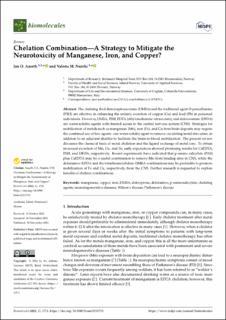| dc.contributor.author | Aaseth, Jan | |
| dc.contributor.author | Nurchi, Valeria M. | |
| dc.date.accessioned | 2023-05-09T13:12:59Z | |
| dc.date.available | 2023-05-09T13:12:59Z | |
| dc.date.created | 2022-12-14T13:07:31Z | |
| dc.date.issued | 2022 | |
| dc.identifier.citation | Biomolecules. 2022, 12 (11):1713, . | en_US |
| dc.identifier.issn | 2218-273X | |
| dc.identifier.uri | https://hdl.handle.net/11250/3067321 | |
| dc.description.abstract | The chelating thiol dimercaptosuccinate (DMSA) and the traditional agent D-penicillamine (PSH) are effective in enhancing the urinary excretion of copper (Cu) and lead (Pb) in poisoned individuals. However, DMSA, PSH, EDTA (ethylenediamine tetraacetate), and deferoxamine (DFOA) are water-soluble agents with limited access to the central nervous system (CNS). Strategies for mobilization of metals such as manganese (Mn), iron (Fe), and Cu from brain deposits may require the combined use of two agents: one water-soluble agent to remove circulating metal into urine, in addition to an adjuvant shuttler to facilitate the brain-to-blood mobilization. The present review discusses the chemical basis of metal chelation and the ligand exchange of metal ions. To obtain increased excretion of Mn, Cu, and Fe, early experiences showed promising results for CaEDTA, PSH, and DFOA, respectively. Recent experiments have indicated that p-amino salicylate (PAS) plus CaEDTA may be a useful combination to remove Mn from binding sites in CNS, while the deferasirox-DFOA and the tetrathiomolybdate-DMSA combinations may be preferable to promote mobilization of Fe and Cu, respectively, from the CNS. Further research is requested to explore benefits of chelator combinations. Copyright: © 2022 by the authors. Licensee MDPI, Basel, Switzerland. This article is an open access article distributed under the terms and conditions of the Creative Commons Attribution (CC BY) license (https://creativecommons.org/licenses/by/4.0/). | en_US |
| dc.language.iso | eng | en_US |
| dc.publisher | MDPI | en_US |
| dc.relation.uri | https://www.ncbi.nlm.nih.gov/pmc/articles/PMC9687779/pdf/biomolecules-12-01713.pdf | |
| dc.rights | Navngivelse 4.0 Internasjonal | * |
| dc.rights.uri | http://creativecommons.org/licenses/by/4.0/deed.no | * |
| dc.subject | DMSA; | en_US |
| dc.subject | Parkinson's disease; | en_US |
| dc.subject | Wilson's disease; | en_US |
| dc.subject | chelating agents; | en_US |
| dc.subject | copper; | en_US |
| dc.subject | deferasirox; | en_US |
| dc.subject | deferiprone; | en_US |
| dc.subject | iron; | en_US |
| dc.subject | manganese; | en_US |
| dc.subject | neurodegenerative diseases; | en_US |
| dc.subject | p-aminosalicylate; | en_US |
| dc.title | Chelation Combination - A Strategy to Mitigate the Neurotoxicity of Manganese, Iron, and Copper? | en_US |
| dc.title.alternative | Chelation Combination - A Strategy to Mitigate the Neurotoxicity of Manganese, Iron, and Copper? | en_US |
| dc.type | Peer reviewed | en_US |
| dc.type | Journal article | en_US |
| dc.description.version | publishedVersion | en_US |
| dc.rights.holder | Copyright: © 2022 by the authors. Licensee MDPI, Basel, Switzerland. This article is an open access article distributed under the terms and conditions of the Creative Commons Attribution (CC BY) license (https://creativecommons.org/licenses/by/4.0/). | en_US |
| dc.source.pagenumber | 13 | en_US |
| dc.source.volume | 12 | en_US |
| dc.source.journal | Biomolecules | en_US |
| dc.source.issue | 11 | en_US |
| dc.identifier.doi | 10.3390/biom12111713 | |
| dc.identifier.cristin | 2093099 | |
| cristin.ispublished | true | |
| cristin.fulltext | original | |
| cristin.qualitycode | 1 | |

